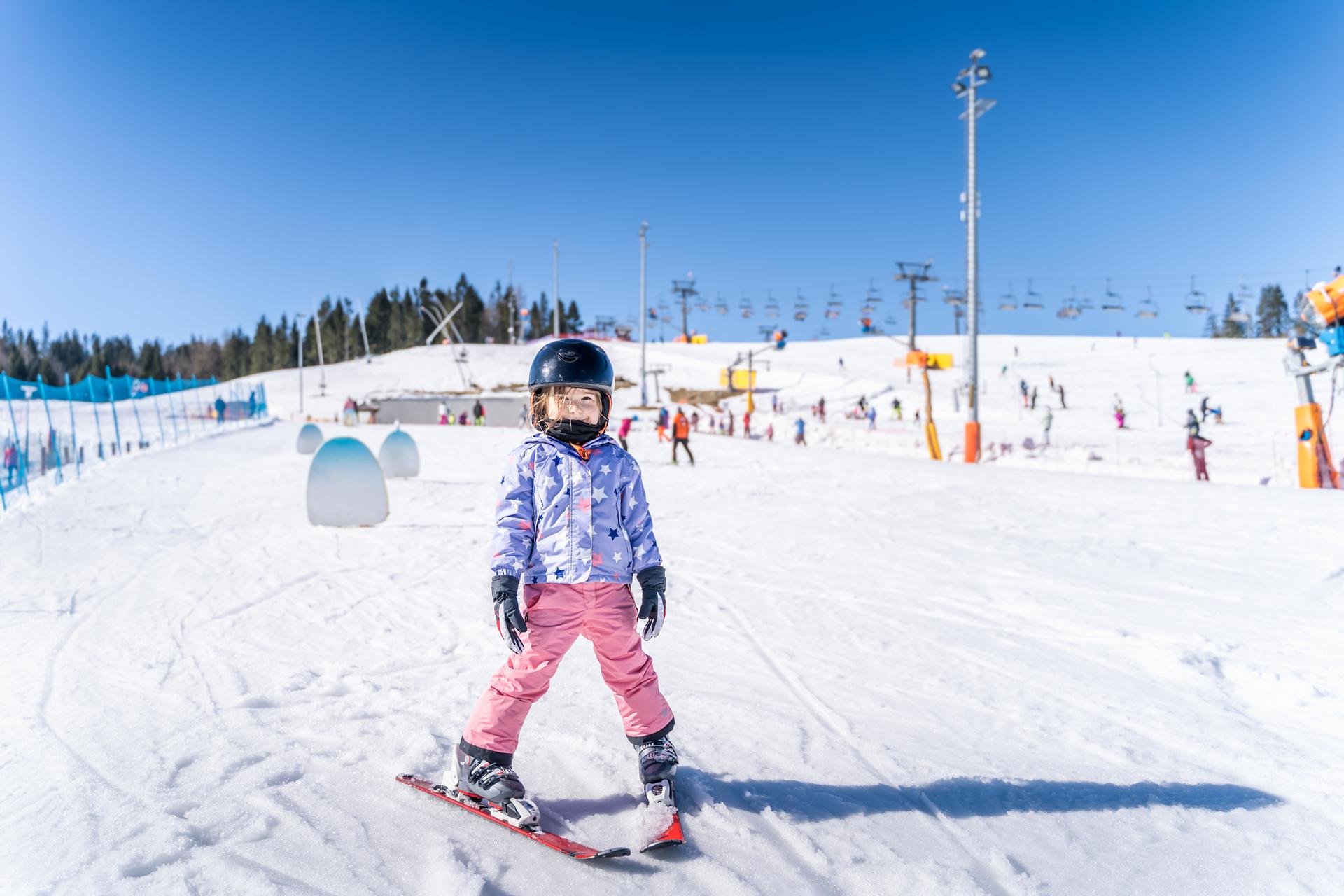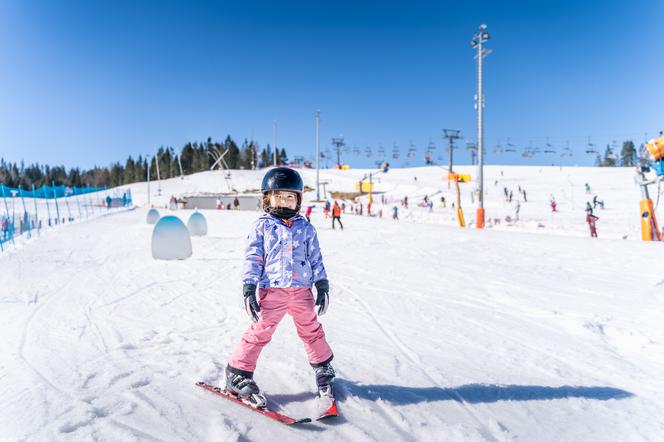
Which skis to choose? This question is asked primarily by beginners, but also by those who have already taken their first steps on skis and would like to buy equipment for more advanced skiers or simply spice up their winter madness on the slopes. Thanks to our guide, you will learn what type of ski to choose, how to adjust them to your height, as well as how to choose poles, bindings and boots for them.

Contents
Many people wondering which skis to choose do thorough research on the Internet before shopping, ask more experienced friends or place high hopes on the good advice of the seller in a sports store. No wonder – the purchase of downhill skis is not the cheapest, so we do not buy a new model every season: we want the equipment purchased once to prove itself for several years.
So what should you pay attention to when buying skis?
How to choose the length of skis according to your height?
When choosing the length of the skis, we must first of all consider where – on the slope or off-piste – and what technique we want to ski. The main rule is that the longer the ski, the greater its stability and adhesion to the ground, which is especially important at high speeds. On the other hand, such equipment is less prone to twisting, and the turns are longer.
On the other hand, shorter skis are recommended for people who like smaller turns and riding at a moderate speed. It is worth remembering, however, that on shorter skis it is easier to capsize at high speed, because their tips can get into uncontrollable vibrations.
It is assumed that shorter skis are better for lighter people, and longer ones – for heavier people, and short skis are more often recommended for beginners, because they work better at low speed. Long skis are more useful for people who already ski confidently and quickly on the slope.
Beginners should buy skis about 15-20 cm shorter than their height. It’s best that for beginner women they reach the chin, and for men – up to the nose. As you progress, the length of the skis also increases.
Read also: Warming up on the slopes
Slalom skis have a standard length of 155 cm for most women and short men and 165 cm for most men and tall women. Giant skis are usually selected exactly to the skier’s height, but they are already equipment for advanced people.
At the first purchase, retailers in sporting goods stores will usually help you choose the right length of skis.
Read also: Skis: rent or buy? Which option is more profitable?
Parameters of downhill skis
How to choose the width of the skis?
Width is another factor we consider when choosing downhill skis. In the past, the most popular were traditional skis, i.e. those that have the same width along their entire length or slightly narrow from the tips (front of the ski) to the heels (back of the ski). Today, the vast majority of skis in stores are carving skis. What distinguishes them? They are wider at the beaks, narrowed at the shoe – they have the so-called. waist – and then wide again at the heels. Thanks to this, it is much easier to ride them, especially to enter corners, and at the same time control the pace of driving.
Skis over 80mm wide are great on and off piste as they have more buoyancy in powder. In turn, the narrower ones are designed mainly for riding on a more compacted surface and are better suited to intermediate or advanced skiers.
Read also: Do a dry mortar before going skiing
Longitudinal stiffness of the ski
After length and width came stiffness. In this case, it is believed that the less experienced the skier, the more he should lean towards less rigid skis, because the harder the board, the more demanding it is. A less stiff ski adheres better to the ground, while a stiffer ski allows you to achieve more speed on paved slopes. Most often, the wider the ski, the larger the size and turning radius of the ski.
Ski lateral hardness
When choosing skis, it is also worth considering their hardness. The principle is similar to that regarding stiffness – the harder the board, the harder it is to ride, therefore it is intended for more advanced skiers. Hard skis make cornering harder, but they stick to the surface better than softer skis. On the other hand, in soft ones it is easier to turn and move at a moderate pace.
Read also: How to turn on skis? Learning to plow and parallel NW turns
See what our expert Michał Jędrasik, a ski instructor from the Strefa Ruchu Ski School, says about how to choose equipment for downhill skiing
Which ski shape to choose: camber or rocker?
Skis can be classified not only by their width or length seen from above, but also by their shape when viewed from the side. The most popular – carving – are divided into two types: camber and rocker.
The camber ski bends upwards in the middle part when it is not loaded, so it does not stick to the ground. This is different in the case of a rocker ski, the middle part of which adheres to the ground, and the non-adherent parts are only in the tip and tail area. Camber works better on powder and in previous years it was more often produced, now manufacturers are more inclined towards rocker, better adapted to skiing on the slope – this equipment is easier to maneuver and safer in turns.
Types of downhill skis
As traditional – with equal length across the entire width – skis are slowly becoming a thing of the past, carving skis reign on the slopes – with a “waist” in the middle. However, that’s not all, because the carving skis themselves are divided into the following types:
- Frontside – the most popular type of ski, recommended especially to beginners, although they are also used by professionals. Frontside skis are best on paved slopes, with a turning radius of 14 to 28 metres.
- Allmountain – a type of ski intended for intermediate and advanced people. They work well on slopes and trails, they are wider than frontside skis. Their turning radius is up to 20 meters.
- Race – skis designed for experienced skiers who like fast skiing on the slope. They give great stability and control over the descent, but they are quite heavy and operating them requires mastering not the easiest technique. Race skis include slalom skis, which allow you to make small and sharp turns, and giant skis, which allow you to maintain stability in wide turns. Race skis are longer and have a smaller “waist” cut than other models.
- Freeride – skis ideal for skiing off-piste, at high altitudes and on powdery surfaces. They are very wide, thanks to which they do not sink in the snow, and the skier comfortably overcomes it. Designed for advanced people.
- Skitour – skis with bindings reminiscent of cross-country skis, have a large turning radius – over 20 meters and are light. Perfect for winter mountaineering.
- Freestyle – these skis are used by very advanced people. They are short, light and have raised ends that allow you to ride backwards. Designed for acrobatics in skippers.
The construction of each ski consists of:
- noses, i.e. the part located at the front, at the very top of the equipment;
- edges located on the sides of the ski;
- slides, i.e. the bottom part of the ski – the one that touches the ground;
- the waist, that is, the place where the ski narrows – where the boot is attached;
- heel, i.e. the part of the ski placed at the back.
How to choose ski boots?
Ski boots, especially those used by beginners, should be above all comfortable, but at the same time they must be properly fitted. The ski boot consists of…
